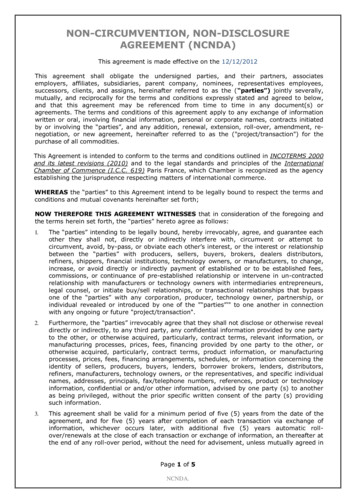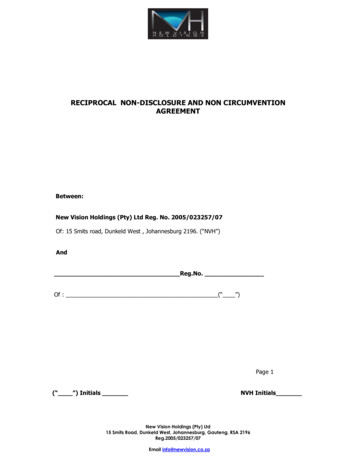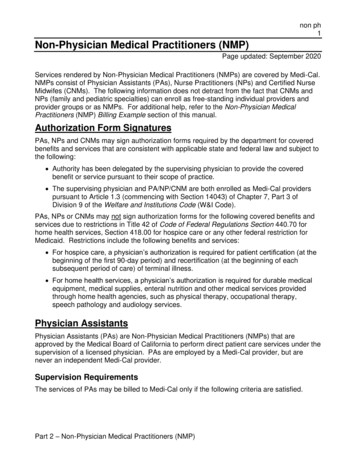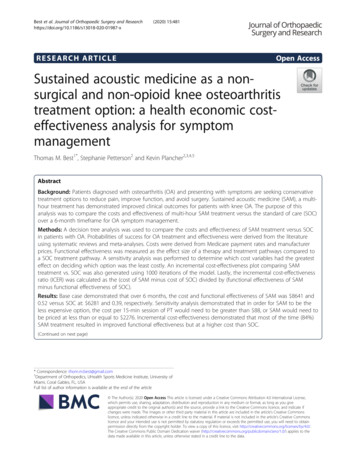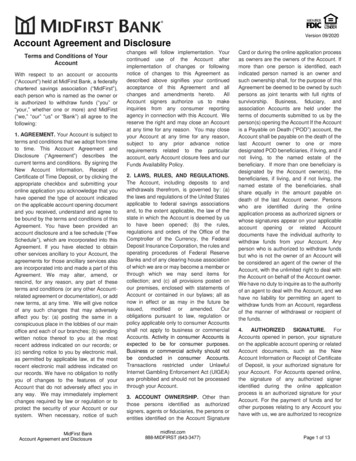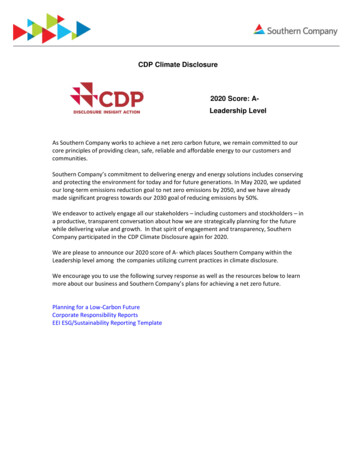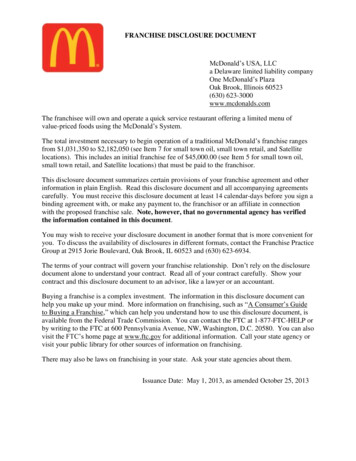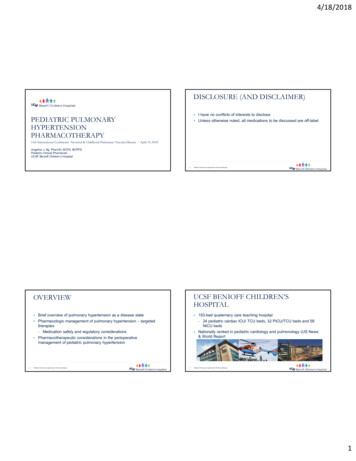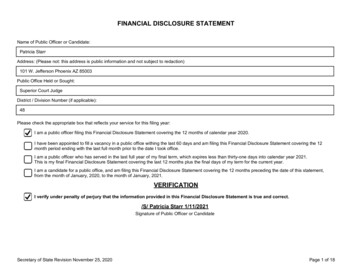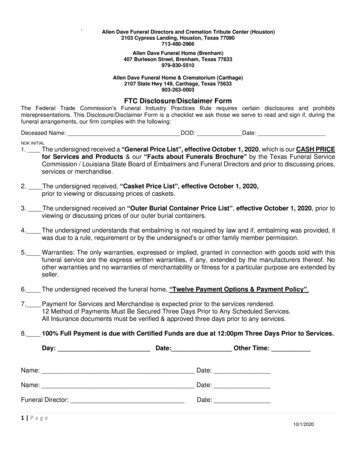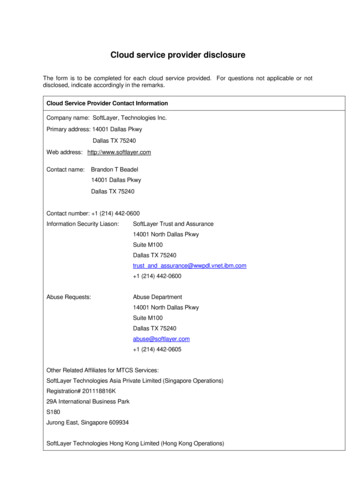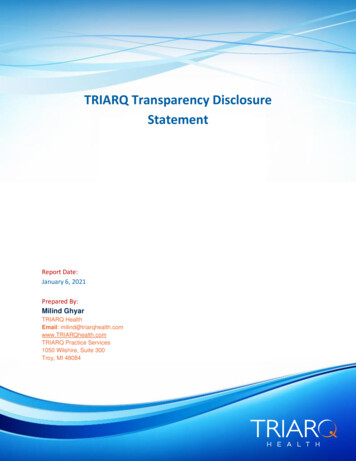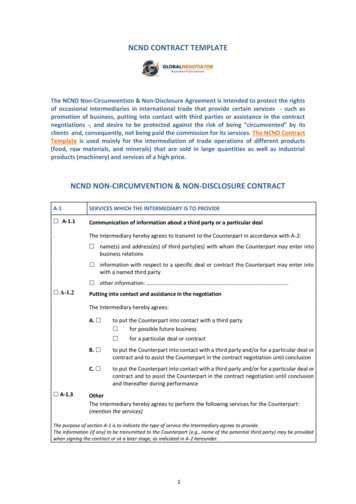
Transcription
NCND CONTRACT TEMPLATEThe NCND Non-Circumvention & Non-Disclosure Agreement is intended to protect the rightsof occasional intermediaries in international trade that provide certain services - such aspromotion of business, putting into contact with third parties or assistance in the contractnegotiations -, and desire to be protected against the risk of being “circumvented” by itsclients and, consequently, not being paid the commission for its services. The NCND ContractTemplate is used mainly for the intermediation of trade operations of different products(food, raw materials, and minerals) that are sold in large quantities as well as industrialproducts (machinery) and services of a high price.NCND NON-CIRCUMVENTION & NON-DISCLOSURE CONTRACTA-1SERVICES WHICH THE INTERMEDIARY IS TO PROVIDE A-1.1Communication of information about a third party or a particular deal.The Intermediary hereby agrees to transmit to the Counterpart in accordance with A-2: name(s) and address(es) of third party(ies) with whom the Counterpart may enter intobusiness relations information with respect to a specific deal or contract the Counterpart may enter intowith a named third party other information: . A-1.2Putting into contact and assistance in the negotiationThe Intermediary hereby agrees:A. to put the Counterpart into contact with a third party for possible future business A-1.3for a particular deal or contractB. to put the Counterpart into contact with a third party and/or for a particular deal orcontract and to assist the Counterpart in the contract negotiation until conclusionC. to put the Counterpart into contact with a third party and/or for a particular deal orcontract and to assist the Counterpart in the contract negotiation until conclusionand thereafter during performanceOtherThe Intermediary hereby agrees to perform the following services for the Counterpart:(mention the services)The purpose of section A-1 is to indicate the type of service the Intermediary agrees to provide.The information (if any) to be transmitted to the Counterpart (e.g., name of the potential third party) may be providedwhen signing the contract or at a later stage, as indicated in A-2 hereunder.1
A-2DISCLOSURE OF INFORMATION TO THE COUNTERPARTThe information which the Intermediary has agreed to provide under A-1.1, A-1.2, or otherwise, will betransferred to the Counterpart as follows:State here how and when (e.g, when signing the contract, or X days thereafter, or after having received a certain sum orguarantee from the Counterpart) the relevant information will be handed over to the Counterpart.A-3A-3.1EXCLUSIVE RIGHTS OF THE INTERMEDIARY (art. 7)With respect to the activity to be performed by the Intermediary in generalA. The intermediary is non-exclusive: the Counterpart remains free to appoint otherintermediaries and to act on its own with respect to the activity entrusted to theIntermediaryB. The intermediary is exclusive: consequently the Counterpart shall not entrust other intermediaries with the same task perform on its own the task entrusted to the IntermediaryC. Remuneration on business made without the intermediary s interventionOn possible direct business by the Counterpart within the scope of the activityEntrusted to the Intermediary, the Intermediary will: be entitled to remuneration. A-3.2not be entitled to remuneration.With respect to the particular deal for which this NCND Agreement is entered intoA. The Counterpart may deal directly with the third partyB. The Counterpart may deal with the third party only through the IntermediaryC. Other: Remuneration with respect to the particular deal will be due:i. in case of conclusion of the contractii. only if the contract has been concluded through the Intermediary's actual interventioniii. other: .A-3.3With respect to contracts with a third party introduced by the Intermediary (customerprotection)A. The Intermediary will not enjoy customer protection, i.e., the Counterpart will be free toconclude contracts with the third party without any obligation towards the Intermediary.B. The Intermediary will enjoy customer protection as specified hereunder1.Third parties to whom the customer protection will apply are: 2.any third parties indicated or contacted by the Intermediaryonly third parties actually contacted through the Intermediary's assistanceother: Extent of customer protection with respect to direct dealings with the third party:2
3.Remuneration with respect to contracts made with protected customers without theIntermediary's intervention A-4A. on all future contracts with protected customersonly on contracts with protected customers concluded through the Intermediary'sactual interventionother: UNDERTAKING NOT TO COMPETEThe Intermediary agrees not to provide its services to competitors of the Counterpart: B. the Counterpart may deal with the third party only through the Intermediarythe Counterpart may deal directly with the third partyother: with respect to the promotional activity it agrees to performwith respect to the third party(ies) indicated to the Counterpartwith respect to the third party(ies) it actually puts into contact with the Counterpartwith respect to the particular deal for which this NCND Agreement is entered intoother: The Intermediary is free to provide its services to any third party, including competitors of theCounterpart.This is a sample of 3 pages out of 13 of NCND Contract.To get more information about this contract click here:NCND NON-CIRCUMVENTION & NON-DISCLOSURE AGREEMENT3
USER GUIDEContracts drafted by the legal experts of Global Negotiator cover all relevant aspects that arenegotiated and agreed in the different types of business between companies. However, whenthese contracts are used you should take into account some recommendations common to allof them that are described in this User Guide.DATEThe date when the contract comes into force is the one that appears in its header, as mentionedin the final paragraphs of the contract, before signatures (This Contract comes into force on thedate written above).In some contracts -for example in the Supply Contract- the date of coming into force is alsomentioned in one of the clauses. In these cases, you have to verify that the two dates insertedin the contract (in the heading and in the corresponding clause) are the same, in order to avoiddiscrepancies.PARTIESBe sure to insert in the first page of the contract the full details of the Parties: When a Party is a company you must insert the following information: legal name, legal form(limited, incorporated, etc.), full address, registration data and fiscal identification number. When a Party is an individual that works as independent professional (for example acommercial agent) you must insert the following information: full name, profession, fulladdress and fiscal identification number.CLAUSESClauses with different alternatives: choose the most favorableIn the most important clauses of each contract (exclusivity, payment terms, applicable law andcompetent jurisdiction, etc.) several drafting alternatives are proposed so you can choose themost appropriate to each situation. Therefore, the user before submitting the contract to theother Party must choose the alternatives that seem best suited to their interests, and eliminatethe rest.Clauses with blank spaces to be completedIn several clauses of the contract blank spaces appear with dots (.) that the userhas to complete inserting text. Following the dots, between brackets, you will see the data andexplanations to insert the text. When the text between brackets is in normal letters (the same as the contract) andseparated by "," or the word "o", the user must insert one of the options suggested.4
Example of blank space (.) with options to select between brackets:Orders handled before completion of the present Contract which produces sales transactionswithin . [1, 2, 3, 6] months shall entitle the Agent to receive the corresponding commission.In this case, the user must choose between options 1, 2, 3 or 6 months and insert one in the blankspace (.). When the text between brackets is in italics the user has to insert the data and informationrequested and eliminate the bracketed text.Example of blank space - (.) to insert text:Both parties, by mutual consent, resolve to refer any dispute to the Rules of Conciliation andArbitration of the International Chamber of Commerce by one or more arbitrators appointed inaccordance with said Rules. The place of arbitration shall be . [city and country]. In thiscase, the user must insert in the blank space (.) the city and country chosen to conductthe arbitration and afterward eliminate the bracketed text [city and country].Notices ClauseSometimes it may happen that the official address of the Parties which appear at the beginningof the contract is different from which is to be used for communications between the Partiesduring the terms of the contract. In this case, the user should include at the end of the contracta Notices Clause.Example of Notices Clause:Notices. - In order to comply with their contractual obligations, the Parties establish thefollowing address for the provision of notices related to this contract:- Party 1 . [insert full address].- Party 2 . [insert full address].ANNEXESThe contracts incorporate some Annexes, each of them, referenced to the corresponding Clause.Annexes are drafted in commonly used formats, although the user must adapt these formatsand the text inserted in them to each particular situation.SIGNATURESPeople who signPersons signing the contract on behalf of the company must have the authority to do so andpreferably, be entitled on the basis of a power of attorney. Below the signature, in addition tothe full name of the person that signs his/her position must be inserted. When one of the Partieswho signs is a natural person (for example a commercial agent in an Agency Contract) obviouslyhe or she is the person that has to sign the contract.5
The laws of some countries require that contracts, to be valid, shall be signed in front ofwitnesses or a public notary. Therefore, before signing a contract you should be informed aboutthe requirements that may exist in each country.Place and date of signatureUsually, contracts are signed by both Parties on the same date and place. Nevertheless, ininternational contracts, due to physical distance, it is common that each of the Parties sign indifferent dates and places. This contract provides for both alternatives so it comes to choosingthe most appropriate to each situation.Number of copiesUsually, the Parties sign two copies of the contract, each Party retaining one of them, but canalso arise the need to sign more copies. In this case, all you have to do is mention explicitly thenumber of copies to be signed in the paragraph that is included at the end of the contract (BothParties declare their conformity to the present contract, which is signed in . copies, each ofwhich shall be considered an original).GENERAL RECOMMENDATIONSThe Parties must sign all pages of the contract, including Annexes, so they are also valid. It isbetter to use ball point or pen (not pencil) in a color other than black (e.g.: blue); this makes iteasier to distinguish an original document from a photocopy.It is preferable (although no mandatory) to express sums of money and percentages in wordsand figures. Of course, the words and figures for a given amount must match exactly. You alsomust insert the currency in which the amounts are expressed. It is advisable to use the rulesestablish by ISO that name each currency by three capital letters (EUR for euro, USD for dollar,GBP for sterling pound, JPY for Japanese yen, etc. - you can get the acronyms of every currencyin the website www.oanda.com).Once you have chosen the best alternatives of each clause and have completed the blank spacesyou should revise the whole contract to remove remaining paragraphs and correct any errors.6
7
The NCND Non-Circumvention & Non-Disclosure Agreement is intended to protect the rights of occasional intermediaries in international trade that provide certain services - such as promotion of business, putting into contact with third parties or assistance in the contractFile Size: 686KBPage Count: 7
